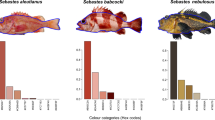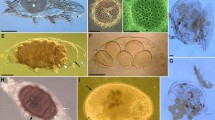Summary
Populations of the rough winkle, Littorina rudis from two spatially-adjacent but distinct habitats have been compared in terms of reproductive effort, size at maturity and embryo size and number. In each case, the basis for the comparison has been examined critically. The suites of characteristics exhibited by the two populations do not fit the conventional ‘r-K’ scheme which has come to dominate life-history theory.
Specifically, individuals in a ‘boulders’ population make a smaller reproductive effort, delay maturity longer and produce more numerous, smaller young than individuals in a ‘crevice’ population.
The effects in the two populations of various environmental factors on shell thickness, animal size and these three life-history traits are examined and discussed. These factors adequately explain the characteristics exhibited by the populations. It is argued that the conventional scheme is inadequate in that it fails to take such specific effects into account.
Similar content being viewed by others
References
Ballantine WJ (1961) A biologically defined exposure scale for comparative description of rocky shores. Field Studies 1:1–19
Berry RJ (1961) Some factors affecting the distribution of Littorina saxatilis. J Anim Ecol 30:127–145
Brownlee KA (1965) Statistical theory and methodology in science and engineering. Wiley, Chichester
Ebling FJ, Kitching JA, Muntz L, Taylor CM (1964) The ecology of Loch Ine. XIII. Experimental observations of the destruction of Mytilus edulis and Nucella lapillus by crabs. J Anim Ecol 33:73–82
Emson RH, Faller-Fritsch RJ (1976) An experimental investigation into the effect of crevice availability on abundance and size structure in a population of Littorina rudis (Maton): Gastropoda; Prosobranchia. J exp mar Biol Ecol 23:285–297
Faller-Fritsch RJ (1977) Reproductive strategies of the winkle Littorina rudis in relation to population dynamics and size structure. In: BF Keegan, PO Ceidigh, PJS Boaden (eds), Biology of benthic organisms: 11th European symposium on marine biology. Pergamon, Oxford p 225–231
Gould SJ (1971) Geometric scaling in allometric growth: a contribution to the problem of scaling in the evolution of size. Am Nat 105:113–136
Hannaford Ellis C (1979) Morphology of the oviparous rough winkle, Littorina arcana Hannaford Ellis, 1978, with notes on the taxonomy of the L. saxatilis species-complex (Prosobranchia: Littorinidae). J Conch 30:45–56
Heller J (1975) The taxonomy of some British Littorina species with notes on their reproduction (Mollusca: Prosobranchia). Zool J Linn Soc 56:131–151
Heller J (1976) The effects of exposure and predation on the shell of two British winkles. J Zool 179:201–213
Horn HS (1978) Optimal tactics of reproduction and life-history. In: JR Krebs, NB Davies (eds), Behavioural ecology: an evolutionary approach. Blackwell Scientific Publications, Oxford p 411–429
Hughes RN, Roberts DJ (1981) Comparative demography of Littorina rudis, L. nigrolineata and L. neritoides on three contrasted shores in North Wales. J Anim Ecol 50:251–268
Naylor R, Begon M (1981) Variation within and between populations of littorina nigrolineata Gray on Holy Island, Anglesey. J Conch (in press)
Pettit CW (1971) Studies on the polymorphism, distribution and laboratory culture of Littorina saxatilis (Olivi) with an Appendix on the land snails of the Madeiran Islands. Unpublished M.Sc. thesis, University of Manchester
Pianka ER (1970) On r- and K-selection. Am Nat 104:592–597
Raffaelli DG (1976) The determinants of zonation patterns of Littorina neritoides and the Littorina saxatilis species-complex. Unpublished Ph.D. thesis, University of Wales
Raffaelli DG (1978) The relationship between shell injuries, shell thickness and habitat characteristics of the intertidal snail Littorina rudis Maton. J Moll Stud 44:166–170
Raffaelli DG, Hughes RN (1978) The effects of crevice size and availability on populations of Littorina rudis Maton and Littorina neritoides (L.). J Anim Ecol 47:71–83
Reimchen TE (1974) Studies on the biology and colour polymorphism of two sibling species of marine gastropods (Littorina) Unpublished Ph. D. thesis, University of Liverpool
Roberts DJ, Hughes RN (1980) Growth and reproductive rates of Littorina rudis from three contrasted shores in North Wales, UK. Mar Biol 58:47–54
Schaffer WM (1974) Optimal reproductive effort in fluctuating environments. Am Nat 108:783–790
Southwood TRE (1977) Habitat, the templet for ecological strategies? J Anim Ecol 46:337–365
Stearns SC (1976) Life history tactics: a review of the ideas. Q Rev Biol 51:3–47
Stearns SC (1977) The evolution of life history tactics: a critique of the theory and a review of the data. Ann Rev Ecol Syst 8:145–171
Tinkle DW, Hadley NF (1975) Lizard reproductive effort: calorie estimates and comments on its evolution. Ecology 56:427–434
Author information
Authors and Affiliations
Rights and permissions
About this article
Cite this article
Hart, A., Begon, M. The status of general reproductive-strategy theories, illustrated in winkles. Oecologia 52, 37–42 (1982). https://doi.org/10.1007/BF00349009
Received:
Issue Date:
DOI: https://doi.org/10.1007/BF00349009




